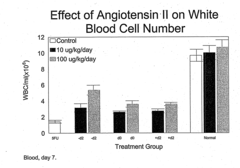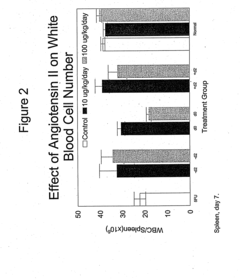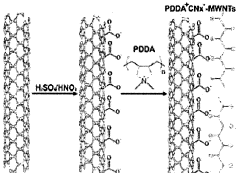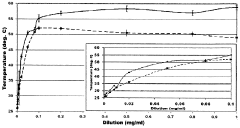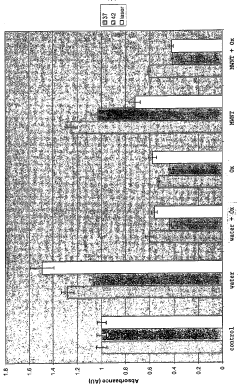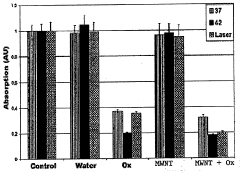Hypertonic Innovations: Progress in Chemotherapy Treatments
Hypertonic Chemotherapy Evolution and Objectives
Hypertonic chemotherapy has emerged as a promising approach in cancer treatment, evolving from traditional chemotherapy methods to address their limitations. The development of this innovative technique spans several decades, with significant advancements in recent years. The primary objective of hypertonic chemotherapy is to enhance the efficacy of anticancer drugs while minimizing systemic toxicity and side effects.
The evolution of hypertonic chemotherapy can be traced back to the 1970s when researchers first explored the concept of using hyperosmotic solutions to alter tumor physiology. Initial studies focused on understanding the effects of hyperosmolarity on cancer cells and their microenvironment. As research progressed, scientists discovered that hypertonic solutions could potentially increase drug penetration into tumors and improve therapeutic outcomes.
In the 1990s, the field gained momentum with the development of more sophisticated delivery systems and a deeper understanding of tumor biology. Researchers began to investigate the combination of hypertonic solutions with various chemotherapeutic agents, aiming to exploit the unique properties of hyperosmolarity to enhance drug efficacy.
The turn of the millennium marked a significant shift in hypertonic chemotherapy research, with a focus on targeted delivery and personalized treatment approaches. Scientists started exploring nanoparticle-based delivery systems and smart polymers that could respond to changes in osmolarity, allowing for more precise and controlled drug release within tumors.
Current objectives in hypertonic chemotherapy research include optimizing drug formulations, developing novel delivery platforms, and elucidating the molecular mechanisms underlying the enhanced efficacy of hypertonic treatments. Researchers are also investigating the potential of combining hypertonic chemotherapy with other treatment modalities, such as immunotherapy and radiation therapy, to achieve synergistic effects.
Looking ahead, the field aims to overcome remaining challenges, such as improving tumor penetration, reducing off-target effects, and addressing drug resistance. Future goals include the development of more sophisticated, patient-specific hypertonic chemotherapy regimens and the integration of advanced imaging techniques for real-time monitoring of treatment efficacy.
As hypertonic chemotherapy continues to evolve, it holds promise for revolutionizing cancer treatment by offering more effective, targeted, and less toxic therapeutic options for patients. The ongoing research and development in this field are expected to contribute significantly to the broader landscape of precision oncology and personalized medicine.
Market Analysis for Hypertonic Chemotherapy Solutions
The market for hypertonic chemotherapy solutions has shown significant growth and potential in recent years, driven by the increasing prevalence of cancer and the demand for more effective treatment options. This segment of the oncology market is characterized by a complex interplay of factors, including technological advancements, regulatory landscapes, and patient needs.
The global market for hypertonic chemotherapy solutions is currently valued at several billion dollars, with a compound annual growth rate (CAGR) projected to be in the high single digits over the next five years. This growth is primarily fueled by the rising incidence of cancer worldwide, particularly in developing economies where access to advanced treatments is improving.
North America dominates the market share, followed by Europe and Asia-Pacific. The United States, in particular, leads in terms of market value due to its advanced healthcare infrastructure and high adoption rates of innovative cancer therapies. However, emerging markets in Asia, especially China and India, are expected to witness the fastest growth rates in the coming years, driven by improving healthcare access and increasing investment in oncology research and treatment facilities.
Key market segments for hypertonic chemotherapy solutions include hospitals, cancer treatment centers, and specialty clinics. The hospital segment currently holds the largest market share due to the complex nature of chemotherapy administration and the need for specialized equipment and trained personnel. However, there is a growing trend towards outpatient and home-based chemotherapy treatments, which may shift market dynamics in the future.
The market is characterized by a high degree of competition, with several major pharmaceutical companies and specialized oncology firms vying for market share. Innovation in drug delivery systems, combination therapies, and personalized medicine approaches are key differentiators in this competitive landscape.
Regulatory factors play a crucial role in shaping the market. Stringent approval processes for new chemotherapy drugs and delivery systems can impact market entry and growth. However, initiatives by regulatory bodies to expedite the approval of cancer treatments are expected to have a positive impact on market expansion.
Patient demographics and preferences are also influencing market trends. An aging population in many developed countries is contributing to the increased incidence of cancer, while a growing emphasis on quality of life during treatment is driving demand for more targeted and less toxic chemotherapy options.
Looking ahead, the market for hypertonic chemotherapy solutions is expected to evolve with advancements in nanotechnology, targeted drug delivery systems, and personalized medicine. These innovations promise to enhance the efficacy of chemotherapy while reducing side effects, potentially expanding the market further.
Current Challenges in Hypertonic Chemotherapy
Despite the promising potential of hypertonic chemotherapy in cancer treatment, several significant challenges persist in its widespread adoption and efficacy. One of the primary obstacles is the difficulty in achieving and maintaining optimal hyperosmolarity within the tumor microenvironment. The dynamic nature of tumor tissues and their surrounding vasculature often leads to inconsistent drug delivery and unpredictable osmotic gradients, potentially compromising treatment effectiveness.
Another critical challenge lies in minimizing systemic toxicity while maximizing local drug concentration. The use of hypertonic solutions can lead to adverse effects on healthy tissues, particularly when administered systemically. Researchers are grappling with the development of targeted delivery systems that can selectively increase osmolarity in tumor regions without affecting normal cells.
The complexity of tumor heterogeneity presents a significant hurdle in hypertonic chemotherapy. Different types of cancer cells within the same tumor may respond variably to osmotic stress, potentially leading to incomplete treatment responses and the development of resistance mechanisms. This heterogeneity necessitates the development of more sophisticated, personalized treatment approaches.
Furthermore, the optimal timing and duration of hypertonic chemotherapy remain subjects of ongoing research. The transient nature of induced hyperosmolarity and its effects on drug uptake and retention require precise scheduling to maximize therapeutic benefits. Determining the ideal treatment regimen for various cancer types and stages poses a considerable challenge for clinicians and researchers alike.
The integration of hypertonic chemotherapy with other treatment modalities, such as radiation therapy or immunotherapy, presents both opportunities and challenges. While combination therapies may enhance overall efficacy, they also introduce complexities in terms of treatment planning, potential interactions, and managing cumulative side effects.
Lastly, the development of reliable biomarkers and imaging techniques to monitor treatment response and guide therapy adjustments in real-time remains a significant challenge. Current methods often lack the sensitivity and specificity needed to accurately assess the effectiveness of hypertonic chemotherapy, particularly in terms of its impact on tumor microenvironment and drug distribution.
Addressing these challenges requires a multidisciplinary approach, combining advances in drug delivery systems, molecular biology, imaging technologies, and computational modeling. As researchers continue to unravel the complexities of hypertonic chemotherapy, overcoming these hurdles will be crucial in realizing its full potential as a powerful tool in the fight against cancer.
Existing Hypertonic Chemotherapy Approaches
01 Targeted drug delivery systems
Advanced drug delivery systems are being developed to improve the efficacy of chemotherapy treatments. These systems aim to target cancer cells more precisely, reducing side effects and increasing the therapeutic index. Techniques include nanoparticle-based delivery, antibody-drug conjugates, and liposomal formulations.- Targeted drug delivery systems: Advanced drug delivery systems are being developed to improve the efficacy of chemotherapy treatments. These systems aim to target cancer cells more precisely, reducing side effects and increasing the therapeutic index. Techniques include nanoparticle-based delivery, antibody-drug conjugates, and liposomal formulations that enhance drug accumulation in tumor tissues.
- Combination therapies: Combining different chemotherapy agents or integrating chemotherapy with other treatment modalities, such as immunotherapy or targeted therapies, has shown promise in improving treatment efficacy. These approaches can target multiple cancer pathways simultaneously, potentially overcoming drug resistance and enhancing overall treatment outcomes.
- Personalized medicine and biomarkers: Utilizing genetic profiling and biomarkers to tailor chemotherapy treatments to individual patients is becoming increasingly important. This approach helps predict treatment response, optimize drug selection and dosing, and minimize adverse effects, ultimately improving the efficacy of chemotherapy regimens.
- Novel drug formulations and delivery methods: Innovative drug formulations and delivery methods are being developed to enhance the efficacy of chemotherapy treatments. These include time-release formulations, oral alternatives to intravenous drugs, and novel administration routes that improve drug bioavailability and reduce systemic toxicity.
- Chemotherapy resistance mechanisms: Understanding and addressing chemotherapy resistance mechanisms is crucial for improving treatment efficacy. Research focuses on identifying molecular pathways involved in drug resistance, developing strategies to overcome resistance, and creating novel compounds that can resensitize resistant cancer cells to chemotherapy agents.
02 Combination therapies
Combining different chemotherapy agents or integrating chemotherapy with other treatment modalities, such as immunotherapy or targeted therapies, has shown promise in improving treatment efficacy. These approaches can target multiple cancer pathways simultaneously and potentially overcome drug resistance mechanisms.Expand Specific Solutions03 Personalized medicine approaches
Utilizing genetic profiling and biomarker analysis to tailor chemotherapy treatments to individual patients. This approach aims to identify the most effective drugs and dosages based on the specific characteristics of a patient's tumor, potentially improving treatment outcomes and reducing unnecessary toxicity.Expand Specific Solutions04 Novel chemotherapy agents
Development of new chemotherapeutic compounds with improved efficacy and reduced side effects. These may include drugs with novel mechanisms of action, enhanced ability to penetrate tumor tissues, or reduced susceptibility to drug resistance mechanisms.Expand Specific Solutions05 Treatment monitoring and optimization
Implementation of advanced imaging techniques, liquid biopsies, and AI-driven analytics to monitor treatment response in real-time. This allows for dynamic adjustment of chemotherapy regimens to maximize efficacy while minimizing toxicity, potentially improving overall treatment outcomes.Expand Specific Solutions
Key Players in Hypertonic Chemotherapy Research
The field of hypertonic innovations in chemotherapy treatments is in a dynamic growth phase, with a market size expected to expand significantly in the coming years. The technology maturity varies across different approaches, with some companies like Merck Patent GmbH, Bristol Myers Squibb Co., and Amgen, Inc. leading in advanced research and clinical trials. Universities such as the University of Southern California and The University of Chicago are contributing to foundational research, while pharmaceutical giants like Sanofi and Janssen Pharmaceutica NV are leveraging their resources to accelerate development. The competitive landscape is diverse, with both established players and innovative startups like Starpharma Holdings Ltd. and EpicentRx, Inc. vying for market share, indicating a robust and evolving sector with potential for breakthrough treatments.
Amgen, Inc.
Bristol Myers Squibb Co.
Breakthrough Innovations in Hypertonic Solutions
- Administration of angiotensinogen, angiotensin I, AI analogues, AI fragments, angiotensin II, AII analogues, AII fragments, or AII AT2 type 2 receptor agonists to increase hematopoietic cell survival and mobilize progenitor cells from bone marrow into peripheral blood, reducing chemotherapy-related side effects.
- The development of compositions comprising nanoparticles, such as carbon nanotubes and inorganic nanotubes, functionalized with chemotherapeutic agents and targeting ligands, which are designed to be administered directly to cancerous tissues and heated using radiation to enhance the uptake and efficacy of the chemotherapeutic agents while minimizing toxicity to healthy tissues.
Regulatory Framework for Hypertonic Chemotherapy
The regulatory framework for hypertonic chemotherapy is a complex and evolving landscape that plays a crucial role in shaping the development, approval, and implementation of these innovative cancer treatments. As hypertonic chemotherapy represents a novel approach to drug delivery, regulatory bodies worldwide have had to adapt their guidelines to ensure patient safety while fostering innovation in this promising field.
In the United States, the Food and Drug Administration (FDA) has taken a lead role in establishing regulatory pathways for hypertonic chemotherapy treatments. The FDA's Center for Drug Evaluation and Research (CDER) has developed specific guidance documents addressing the unique challenges posed by these therapies. These guidelines cover various aspects, including preclinical testing requirements, clinical trial design considerations, and manufacturing standards for hypertonic solutions.
The European Medicines Agency (EMA) has also recognized the potential of hypertonic chemotherapy and has implemented a regulatory framework to facilitate its development within the European Union. The EMA's Committee for Medicinal Products for Human Use (CHMP) has issued scientific advice on the design of clinical trials for hypertonic chemotherapy agents, emphasizing the importance of demonstrating both safety and efficacy in this novel treatment modality.
In Japan, the Pharmaceuticals and Medical Devices Agency (PMDA) has established a regulatory pathway for hypertonic chemotherapy that aligns with the country's focus on accelerating the approval of innovative cancer treatments. The PMDA's framework includes provisions for expedited review processes and conditional approvals, allowing promising hypertonic chemotherapy treatments to reach patients more quickly while still maintaining rigorous safety standards.
Regulatory bodies in other countries, such as China's National Medical Products Administration (NMPA) and Health Canada, have also begun to develop specific guidelines for hypertonic chemotherapy. These frameworks often draw inspiration from established regulatory models while adapting to local healthcare systems and priorities.
A key aspect of the regulatory framework for hypertonic chemotherapy is the emphasis on post-market surveillance and long-term safety monitoring. Given the innovative nature of these treatments, regulatory agencies require robust pharmacovigilance programs to track potential adverse effects and gather real-world evidence on treatment outcomes.
Harmonization efforts, such as those led by the International Council for Harmonisation of Technical Requirements for Pharmaceuticals for Human Use (ICH), are underway to align regulatory requirements for hypertonic chemotherapy across different regions. These initiatives aim to streamline the global development and approval processes for these innovative treatments, potentially accelerating patient access to new therapies.
As the field of hypertonic chemotherapy continues to advance, regulatory frameworks are expected to evolve in tandem. Ongoing dialogue between regulatory agencies, researchers, and pharmaceutical companies will be essential to ensure that the regulatory landscape remains responsive to scientific progress while maintaining the highest standards of patient safety and treatment efficacy.
Patient Safety and Efficacy Considerations
Patient safety and efficacy are paramount considerations in the development and implementation of hypertonic chemotherapy treatments. These innovative approaches aim to enhance the effectiveness of cancer treatments while minimizing adverse effects on patients. However, the use of hypertonic solutions in chemotherapy presents unique challenges that must be carefully addressed to ensure optimal outcomes.
One of the primary safety concerns is the potential for osmotic shifts within the body. Hypertonic solutions can cause rapid fluid movement between intracellular and extracellular spaces, potentially leading to electrolyte imbalances and cellular dehydration. To mitigate these risks, careful monitoring of patients' fluid and electrolyte status is essential throughout the treatment process. Additionally, gradual administration protocols have been developed to minimize the impact of sudden osmotic changes.
Efficacy considerations for hypertonic chemotherapy treatments focus on optimizing drug delivery and enhancing tumor penetration. The increased osmotic pressure created by hypertonic solutions can potentially improve the distribution of chemotherapeutic agents within tumor tissues. This may lead to more effective targeting of cancer cells and reduced systemic toxicity. However, the precise mechanisms and long-term effects of hypertonic drug delivery are still being investigated, necessitating ongoing research and clinical trials.
Another critical aspect of patient safety is the management of potential side effects specific to hypertonic chemotherapy. These may include localized pain or discomfort at the infusion site, temporary changes in blood pressure, and in rare cases, vascular complications. Developing comprehensive protocols for patient monitoring and rapid intervention in case of adverse events is crucial for maintaining safety standards.
The efficacy of hypertonic chemotherapy treatments is closely tied to the ability to achieve and maintain optimal drug concentrations within tumor tissues. Researchers are exploring various techniques to enhance this aspect, including the use of nanoparticle carriers and targeted delivery systems that can leverage the hypertonic environment. These approaches aim to improve the therapeutic index of chemotherapy drugs by increasing their concentration in cancer cells while minimizing exposure to healthy tissues.
As with any novel treatment modality, long-term follow-up studies are essential to fully understand the safety profile and efficacy outcomes of hypertonic chemotherapy. This includes monitoring for potential delayed effects, assessing quality of life metrics, and comparing survival rates with conventional chemotherapy approaches. The accumulation of robust clinical data will be crucial in refining treatment protocols and establishing best practices for patient care.
